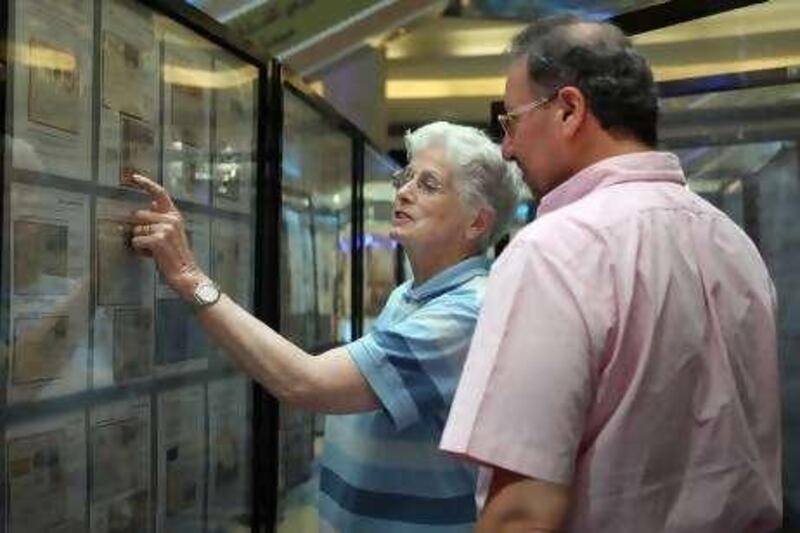SHARJAH // Some may write off philately as a dull hobby, but postage stamps can provide a unique insight into a nation's history. The Arabian Stamp Exhibition, which opened at the Sharjah Mega Mall on Wednesday, displays a selection of the best Middle Eastern-focused collections from around the world. Those from the UAE document the rise and fall of political influences in the country.
A highlight of the exhibition belongs to an Emirati. Ahmad bin Eisa al Serkal's collection, which consists of Abu Dhabi stamps issued between 1963 and 1973, documents the development of the emirate's postal service - which traces its beginnings to the opening of the first Abu Dhabi post office, on March 30, 1963. Stamps of the British Postal Agencies in Eastern Arabia - featuring the likeness of Queen Elizabeth II - were used as official UAE postage until 1964, when the first Abu Dhabi stamps were released: blue, orange, green and brown issues featuring a gazelle, the then-ruler, Sheikh Shakhbut or local landscapes.
When Sheikh Shakhbut abdicated the throne, and his brother Sheikh Zayed bin Sultan, who was to become the founding President of the UAE took over, on August 6, 1966, the stamps were taken out of circulation. As there was no time to issue a new set, the stamps were sent to Bahrain, where a company printed lines over Sheikh Shakbut's portrait to indicate the change in leadership. The stamps were then put back into circulation.
The British Postal Administration in the UAE ended on December 31, 1966, and Abu Dhabi launched its postal service the next day. On Wednsday, mall shoppers were milling about the many stamps on display. "Attendance so far has been pretty strong," said Peter Singer, 66, a dealer from Detroit who is manning a small booth in one of the two areas set aside at the mall for the exhibit.
Mr Singer was invited to participate in the exhibition, the first of its kind in Sharjah. "There are some people collecting here in the UAE, and there are a lot of people with the money to do so, but many are still learning about the hobby," he said, adding that China, another developing part of the world, is one of the most lucrative philatelic markets at the moment. A stamp's value is in many ways reliant on supply and demand, and while UAE stamps are not yet big business, Mr Singer said an increased interest in philately among UAE residents could change that.
In addition to stamps from the Emirates, the exhibit features collections from countries such as Iraq and Oman, and collectors have flown from as far as the UK and New Zealand to show their wares, and perhaps make some deals. Freddy Khalastchy, a fellow of the Royal Philatelic Society London, who was born and raised in Baghdad but has lived in London since he was 16, owns what is arguably the world's finest collection of Iraqi stamps.
"I was invited to show my collection, stamps of Iraq during the [British] occupation between 1917 and 1923," said Mr Khalastchy, 53, whose business is manufacturing ladies' handbags . "When I started collecting stamps as a child, I didn't know anything about the history of the stamps, so I had to go through the old catalogues. I went to the Imperial War Museum and picked up snippets of information," he said. "My father used to collect stamps, and he gave me quite a collection."
"At the moment, Iraq is a popular country among collectors, especially since 2003," Mr Khalastchy said. "It has been in the news, and there is a new generation of Iraqis who have the money and have started to collect." Yahya Jafar, 69, who is from Baghdad, has been living between Iraq and Dubai since the 1970s. He began collecting stamps 30 years ago, and his catalogue of "Iraqi stamp errors" dating from between 1967 and 1990 is on display in the local section of the exhibit.
Printing errors greatly increase the value of a stamp, though Mr Jafar says his main motivation is an interest in his country's history. "It is a nice pastime, and it is nice to collect something," he said. "I have about 1 per cent of Freddy's collection, but it is interesting. I believe the mistakes were deliberately made by the printing companies to win contracts in Iraq at the time." For collectors interested in improving the way they display their stamps, Norman and Jenny Banfield, collectors from New Zealand, are conducting workshops at the exhibition.
Mrs Banfield is also displaying her "Postal History Study of Airmails from Iraq, 1919-45". "I didn't start collecting until I was 65," said Mrs Banfield, 76. "My husband has collected all of his life. [Iraq] just fascinates me - the history. [It] was really the cradle of civilisation, and the more you get into it, the more you learn. I grew up in England and so I didn't learn about Middle East history. I knew nothing until I started collecting."
The Arabian Stamp Exhibition ends on Monday. @Email:loatway@thenational.ae
For a multimedia feature about UAE stamps, visit https://www.thenationalnews.com/stamps






